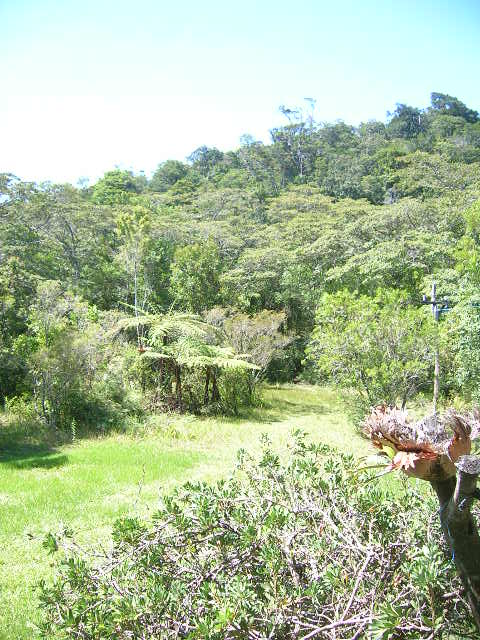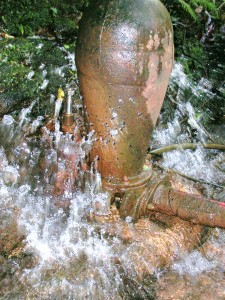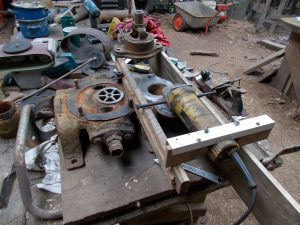
When I first came to Possum Valley 40 years ago, there was no road in and no even a walking track. I hacked a way through the rainforest, set up tiny tent and a few sheets of tin on wobbly poles for a kitchen and started building a house, now Blackbean Cottage. After about 5 months all the framing was up and tin on the roof, but no cladding on the walls and no boards on the floor except for the loft. I decided to move out of the tent up to the loft for a bit more elbow room. Just as well I did as 2 days later a cyclone hit with massive amounts of rain. Over 2000 mm fell in 5 days. I was gobsmacked. I never knew there could be that much rain in the whole world. I had no warning, being quite out of touch with the rest of the world, but in 1976 there wasn’t much warning to anyone in North Queensland. There was no radar in the whole of the north of Australia and of course no satellite images. The only way the met office knew about cyclones was from very scattered isobar readings and radio reports from ships unfortunate enough to be somewhere near. And the location of the eye or the intensity was guesswork little better than tea-leaf reading. Astute readers will have already guessed I survived my first cyclone.
Cladding, windows and doors (all second hand) were soon added and the interior fixtures, with of course the first being the kitchen sink, also second hand. Work progressed, but I soon got tired of having to go down to the creek in rain or shine for a bucket full of water. It was only 20 m to good water, but it quickly got to be a tiresome chore. To this day there are young girls in Africa and Asia trekking up to 5 kms to water of dubious quality to stagger back with as much as they can carry. Pause for thought.
So for Possum Valley to enter the 19th century, running water was required. Now dear readers, I finally get round to introducing that marvel of engineering, the powerless pump … the ram pump. And this was the first time I had ever heard of such a thing, when researching how to get water from the creek up to my kitchen sink. I want one of those! and found one in Atherton secondhand store.

Ram Pump
A brilliant juxtaposition of poverty and opportunity! A friend had a small metal water tank with rust holes and I lined it with chicken wire and concrete plastered on with the back of a spade. 40 years later and long past its use, I have had to tip it over to drain it because it is still watertight and a potential mosquito breeding site. I set up the ram pump and the tank connected by plastic pipe and had running water. My dear readers, brought up in an affluent society will have a hard time grasping what a momentous occasion this was. I was like Homer Simpson gasping in wonder and turning the tap. Water on, water off, water on….
The water system has undergone many updates since then but always reliant on a ram pump, now upgraded to the mighty Billabong No 6. It has performed magnificently for 30 years, but in the last few weeks had a catastrophic failure of the clapper valve flange. Few readers will have suffered such an affliction to your clapper valve, but I can assure you it is very serious, causing a rupture of the gasket, an embarrassing leakage and total failure to ram it up to the top tank. It was bought second-hand and may have had a life of 30 years or more before I acquired it so some deterioration after 60 years of use may be expected I suppose. Inspection of the flange showed visible corrosion and radial erosion gullies caused by extremely high pressure water blasting out and the accumulated damage was now too much for the gasket rubber to seal. I would have to machine the damage out then get both metal surfaces flat to less than a tenth of a millimeter to be sure of a seal. Getting two surfaces 200 mm by 120 mm flat and mating is not as easy as it sounds and requires a reference flat surface. The most accurate I guessed would be on my wood planing machine which has ground steel tables each side of the planer drum, but it is not at all portable. The next best was the ground table on my pillar drill, but I didn’t altogether trust that fairly cheap machine. For the brass flange of the clapper valve I took out the visible ruts and ridges with a belt sander, checking it from time to time by rubbing on the pillar drill table with a thin smear of ink from a rubber stamp pad. No ink on the flange and you have a dip, where you can see ink you have a lump. Then I finished off by clamping fine sandpaper on the planer table and hand rubbing the brass clapper valve on top of it.
The flange on the pump body was going to be more of a challenge being a cast steel lump I could barely lift. The depth of the erosion would require aggressive machining to take off at least 1 mm. It would require my angle grinder, but one little slip would gouge out a couple of mils making it worse than when I started, so a jig was required to prevent me from buggering it up. I would use the grinding disc carefully aligned to be flat and parallel on 2 axes.

Jig for machining ram pump
See the pic and the add-ons to the grinder so it could only glide in a flat plane. I was enormously pleased with myself for having contrived this clever solution. What I didn’t know was that though grinding discs destroy even the hardest steels at a great rate in a most satisfying shower of sparks when presented edge on, when presented flat on they give a feeble display of sparks then cease to function. A network of reinforcing fibers soon emerges to facilitate the disc gliding effortlessly across the steel with to no effect. Fortunately, I had a fair stock of discs and by changing frequently I managed to use the thin layer of abrasive particles on each of them. So I managed to grind out the 60 years of corrosion and use, erosion and blast lines. Now to hone it flat. I couldn’t use the method of rubbing it on the planner table, as both devices rather massive, so I used a combination of the ink smear method using the newly machined brass flange and the straight edge of a steel ruler and feeler gauges. My new tool was an old wood plane with a flat ground shoe to which I clamped abrasive paper. By constantly altering my rubbing direction I wore down the high spots.
Then the pump was assembled and soon back in operation. Of course it will all have to be done again in another 60 years and I’m looking forward to it.
I love reading your blogs…i couldnt see for tears from laughter at one point…then am amazed at your knowledge and resilience next! I agree with ross and susan above…Pauls Book of Blogs would be a bestseller! Keep them coming and thanks for giving me a smile to start my day!
Vicki..in Kennedy.
I hope you intend putting all your fascinating, funny and interesting blogs into a book one of these days. It would be a best seller!
Susan and Ross – Cairns
PS. I hope the owners of the “selfie stick “ that we found and placed in the sauna came back and reclaimed their gadget!
I can hardly believe that the ramblings of a bush bodger are of interest to anyone, let alone amassed into a pile of self indulgence. But thanks for your kind comment. I still have the selfie stick. Not much use to me as I have never owned a mobile. I tried to give it away but couldn’t find anyone sufficiently narcissistic, so my grandkids use it as a play pole saw.